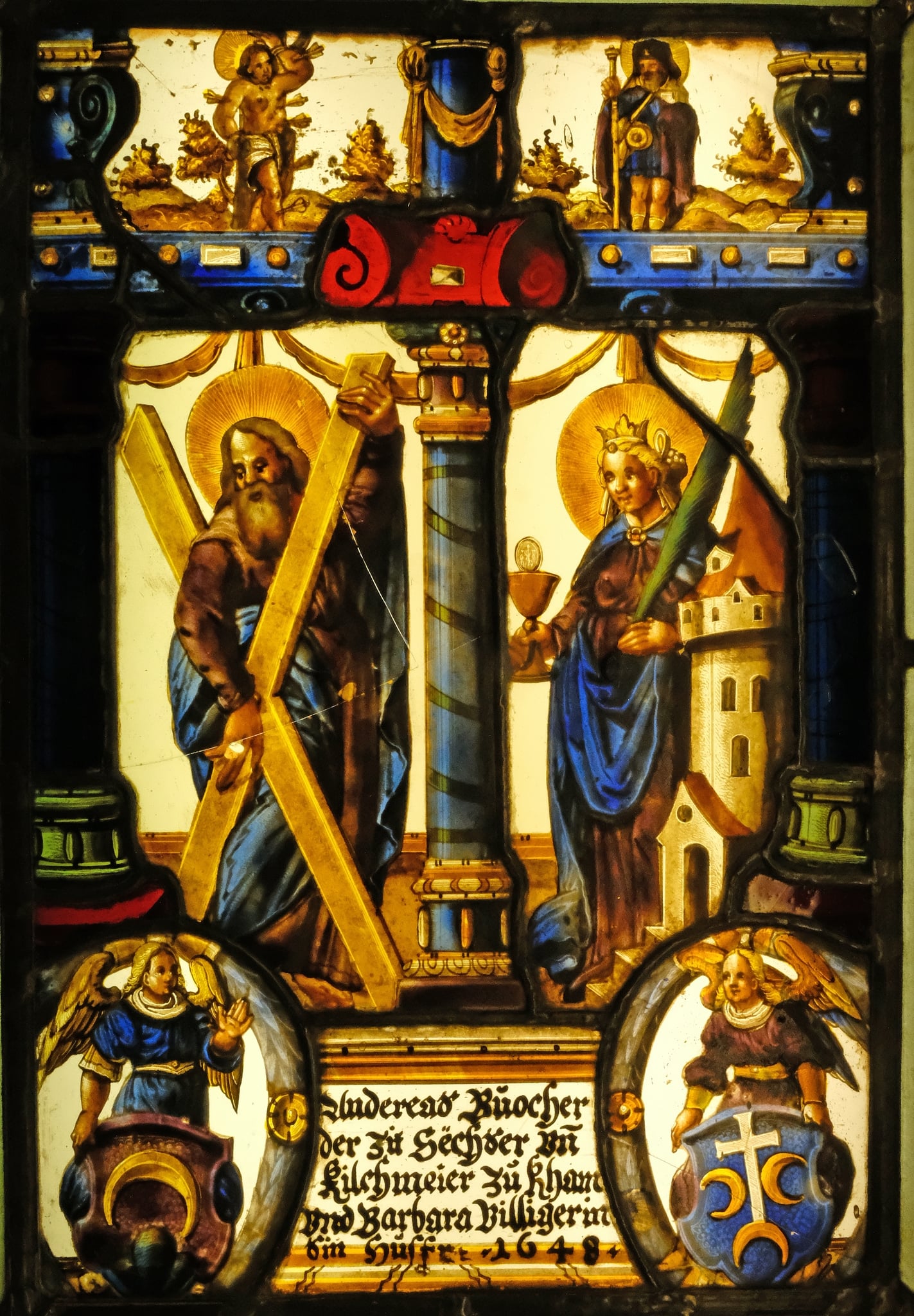Several windows associated with Paul Müller contain elements similar to those of the Baltimore panel. An Alliance panel of Metzener and Müller showing the Virgin on the Half-moon flanked by Saints John the Baptist and Catherine displays the same architectural concepts (Swiss National Museum, Bergmann, 2004, pp. 321–22, no. 121, fig. 121.1). A horizontal lintel is divided by a curving volute framed by heavy bases with double volutes. The central scene is divided by columns framing single standing figures. The figure of St. Catherine is almost the same model as that used for St. Barbara in the Baltimore panel. Below, an inscription panel is associated with a laurel wreath surrounding an angel who supports a shield. In this panel, an image of the martyrdom of St. Sebastian matches the saint depicted in the Walters’ panel. Another panel, dated 1639, attributed to Paul Müller uses the same winding stripe around the column (Zug, Museum in der Burg Zug, Inv. Nr. 3329; Bergmann, 2004, pp. 326–27, no. 125). Similarly, figures of saints stand above the lintel and an angel supporter holds a shield within an olive wreath. A panel of 1641 from the Müller workshop, possibly by Paul Müller, follows these formats, with swags between the columns, simple, heavy architectural forms, and a row of patron saints above the lintel (Zug, Museum in der Burg Zug, Inv. Nr. 8708; Bergmann, 2004, pp. 333–32, no 131).
The panel is a personalized expression connected to the donor couple with their name-saints. St. Andrew, one of the Apostles, was highly revered. Jacobus de Voragine’s Golden Legend: Readings on the Saints (Ryan, 1993, vol.1, pp. 13–21), recounts that he preached with great success in Achaea, Greece, but when he refused to obey the order of the Roman proconsul to “sacrifice to idols” he was tied to a cross from which he preached for three days before he died. The cross on which he suffered is commonly depicted as having X shape, now known as St. Andrew's cross, a tradition that does not appear to predate the fourteenth century (MacRory, 1907. See the similar representation of St. Andrew in a panel in the Monastery of Wettingen given by Abbot Thomas Wunn of Salem in 1623; Hoegger, 2002, pp. 27, 150, 351–52). The panel is attributed to a painter also from Zug, Christoph Brandenberg (ca. 1598 or 1600–1630; Bergmann, 2004, pp. 103–107). Both artists were arguably relying on the same model.
St. Barbara does not appear in the Golden Legend. Along with Barbara and Catherine she formed a trio referred to as the “three holy maidens.” These three were the female representatives within the Vierzehnheiligen (The Fourteen Helping or Auxiliary Saints), an association that had begun in the fourteenth century in response to the Plague. The devotion enabled the faithful to address each of the saints for the cure of specific diseases or for other petitions. Barbara stands by a tower and holds a chalice and host in her right hand. The host is a reference to Barbara’s power, shared with several other saints of the time, to help one avoid an untimely death, that is, a death without the sacraments. Barbara’s special function, however, was as the patron of those who worked with explosives. Her father, who had imprisoned her in the tower, and ultimately beheaded her, was punished by being struck by lightning (Réau, 1955–59, vol. III/1, pp. 169–77). In the fifteenth century, those who worked with firearms selected Barbara as their patron. At first, the artillery invoked her protection, then others working with explosive materials; she thus became the patroness of many guilds and corporations.
Equally localized and personalized are the two saints at the top. The most characteristic aspect of Sebastian’s martyrdom included his being shot with arrows (Ryan, 1993, vol.1, p. 100). Subsequently, like many of those tried by multiple tortures, he was miraculously healed. The most commonly cited legends relate his being nursed back to health by St. Irene and his ultimate martyrdom by being beaten to death. The model of being pierced with arrows was a metaphor for illness and death from classical times; Apollo is depicted as an archer causing death in the Iliad (1.43–52). The story encouraged Sebastian’s position as a healing saint, especially for plague victims. The later Golden Legend cites an account from the History of the Lombards (Historia Langobardorum), written in the eighth century by Paul the Deacon, that attested to Sebastian’s power as a healer of the plague (Ryan, 1993, vol. 1, p. 101).
To the right is St. James the Great, dressed as a pilgrim. He carries a staff, hangs a canteen from his belt, and wears a hat with the scallop shell insignia of those who have made the trip to his shrine in Santiago de Compostela. The pilgrimage route Jakobsweg from Lake Constance to Geneva was well established in Switzerland. The pilgrimage chapel of St. Jost in Galgenen is less than 40 kilometers distance from Cham, the residence of the donors (Jörger, 1989, pp. 124–153).
Cited in:
Hayward, Kummer-Rothenhäusler, & Raguin, 1987, p. 68.
Hayward, Kummer-Rothenhäusler, & Raguin, 1989, p. 311.
